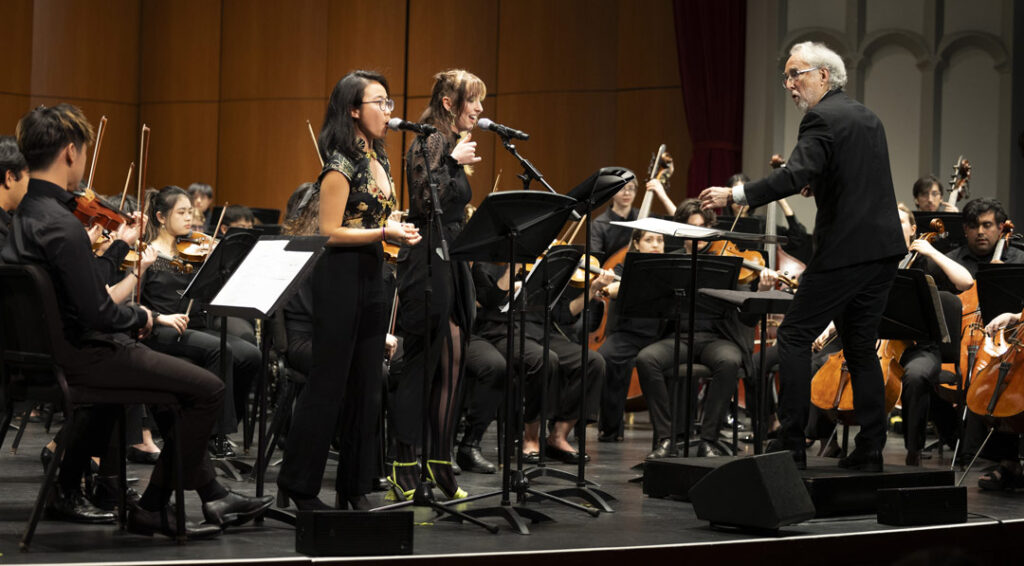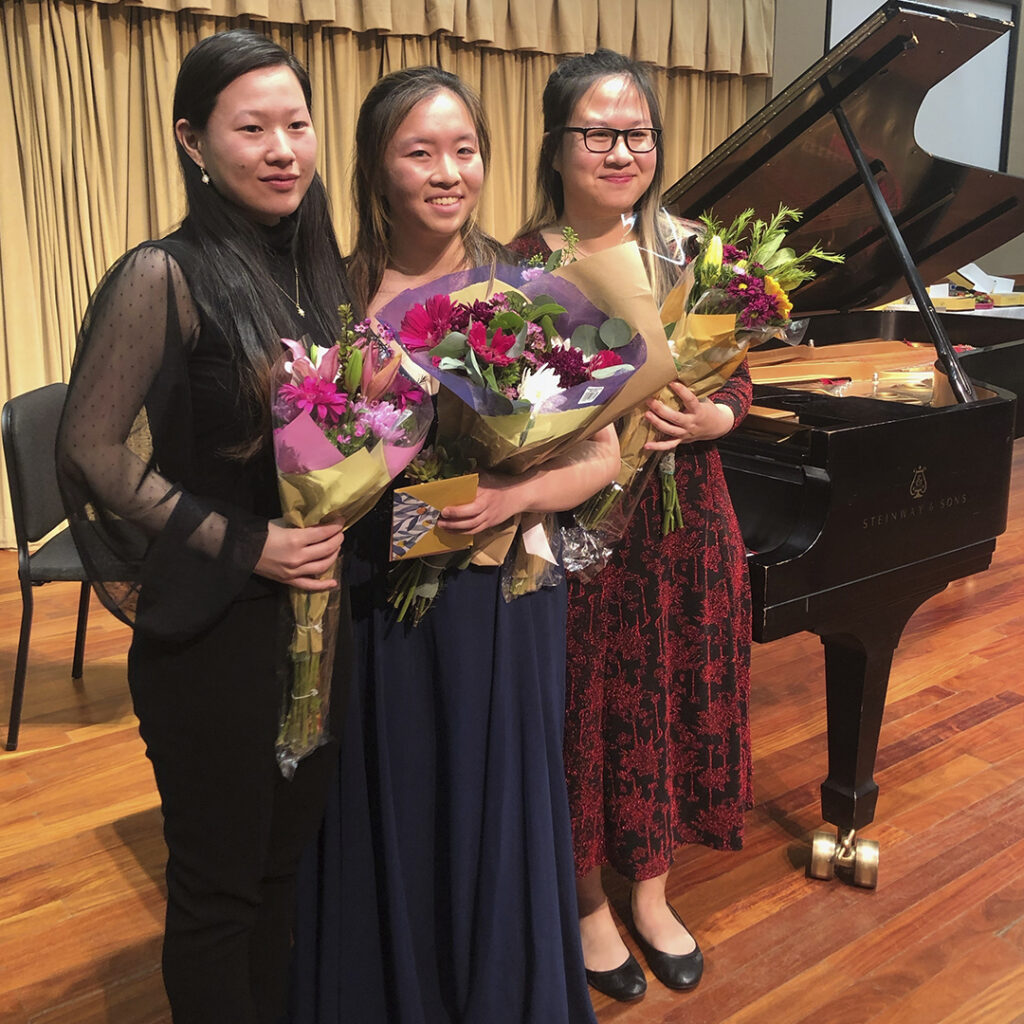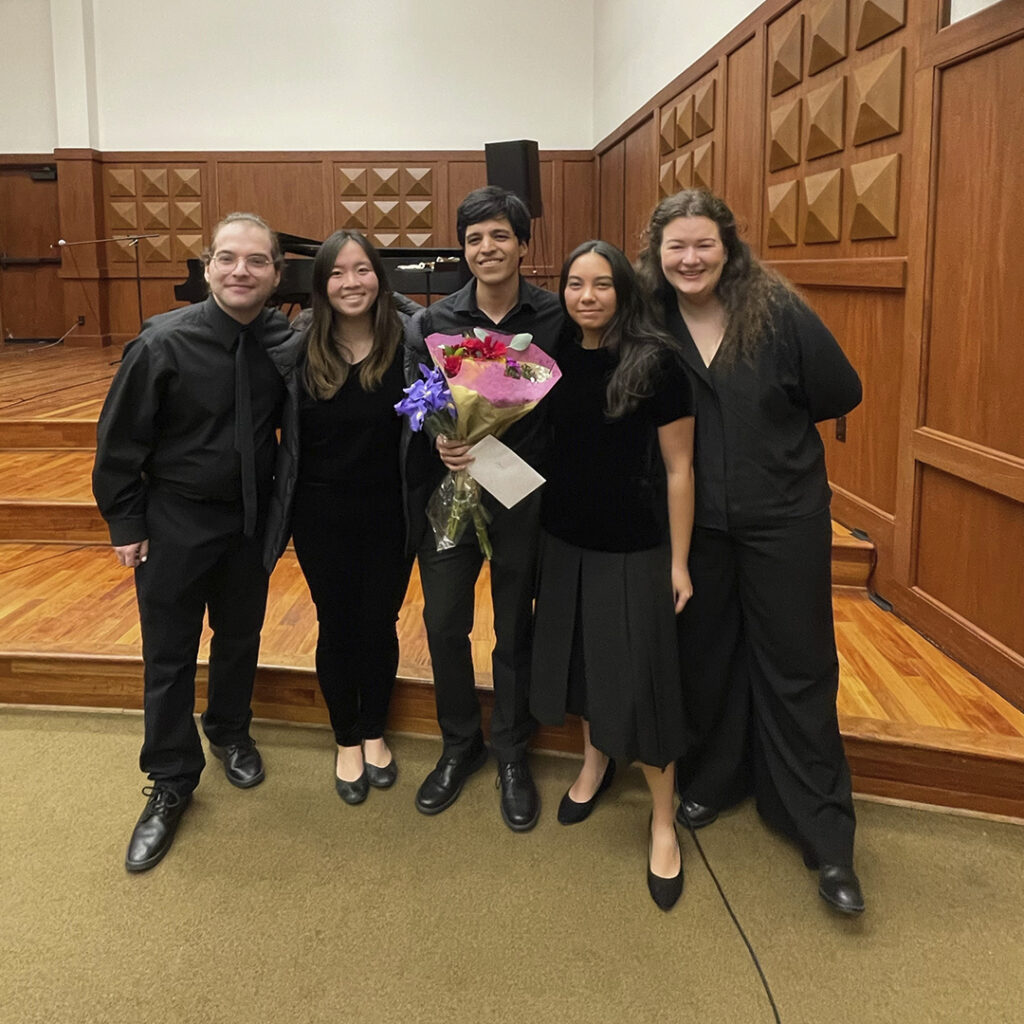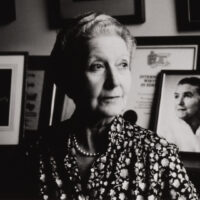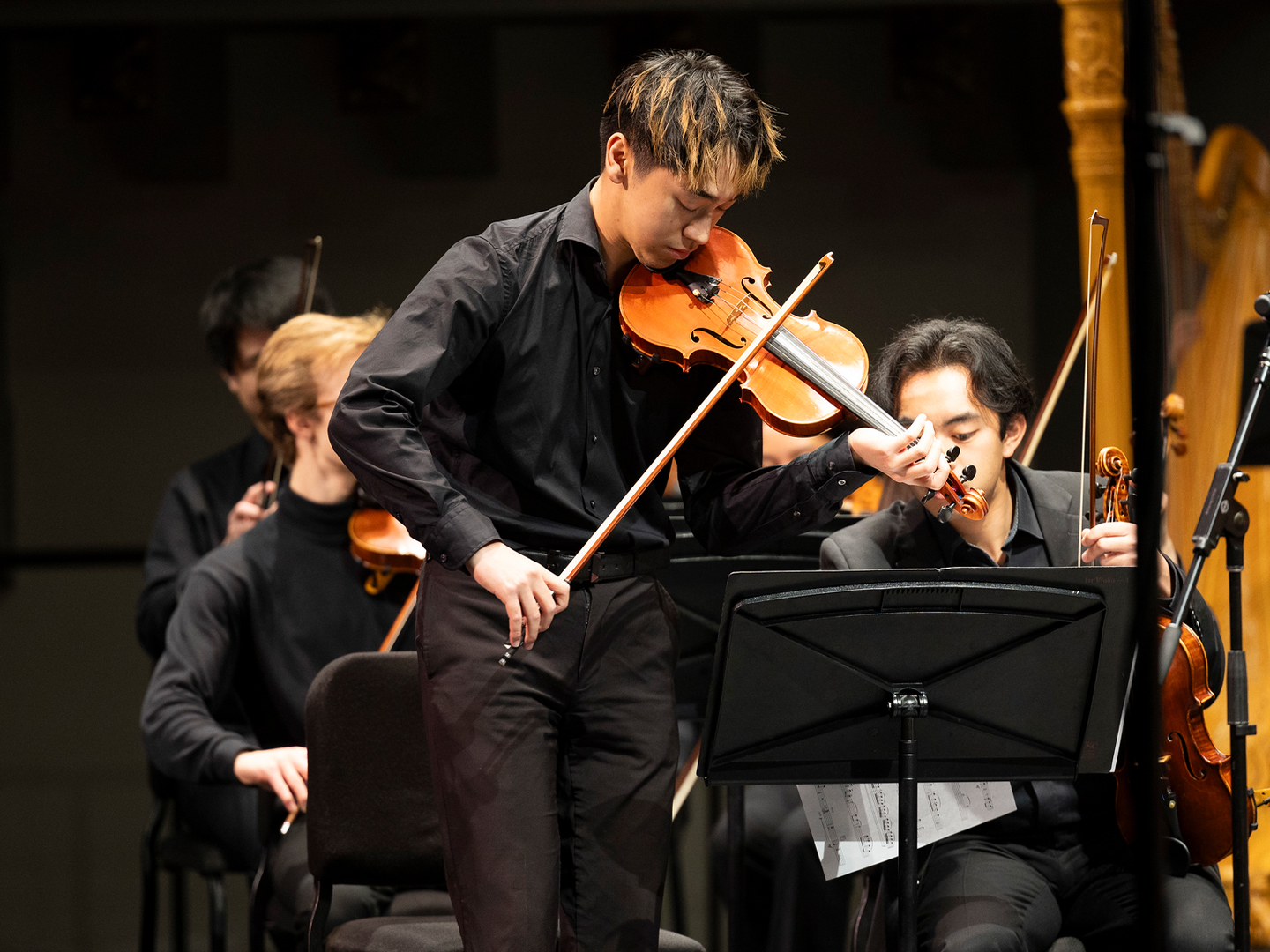
Ambassador Blog: Performance Opportunities
By Sofia Chamberlain, Emily Hsu & Ella Kaale
USC Thornton Student Ambassadors Sofia Chamberlain, Emily Hsu and Ella Kaale share the performance opportunities they’ve had within the Strings and Composition departments.
Sofia Chamberlain (Violin Performance, Biological Sciences | Class of 2024) and Emily Hsu (Violin Performance, Business Administration | Class of 2024)
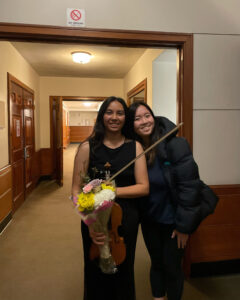
The most prominent performance opportunities for a Classical Division Strings student are with the Thornton Symphony Orchestra, which consists of both undergraduate and graduate Strings majors. There are approximately four to five rotations every semester and each student is usually allowed one performance off per semester to help balance other opportunities or responsibilities that we might have as students. Each rotation lasts about two weeks, with on average, six rehearsals and a concert. A particularly fun and appealing characteristic of the Orchestra is that we operate with rotating seat assignments. We both have found this system to be a great learning opportunity, as we are able to sit next to a different person every rotation and learn from their orchestral experience. At the beginning of each academic year, auditions are held to determine which students will make up the pool of concertmasters and principals. From then on, every rotation has different seating assignments, which helps provide students with various perspectives within the ensemble itself.
The USC Thornton Symphony strives to prepare the students for the professional orchestral world by immersing us within a pseudo professional atmosphere and as such, we are privileged to have access to respected working professionals. We often play with esteemed guest conductors and are mentored by faculty members who either are or were once in a major orchestra (Los Angeles Philharmonic, New York Philharmonic, etc.). Additionally, the quick-paced nature of the rotations does not compromise the difficulty of repertoire. In fact, each work is carefully picked with the intention of challenging and exposing the students to the usual standard works major orchestras usually perform. For example, we recently performed Strauss’s Ein Heldenleben and Jennifer Higdon’s blue cathedral under Maestro St.Clair. Overall, the continuous exposure to differing musical perspectives, difficult repertoire, and access to working professionals and amazing faculty members shapes every student into a well-rounded musician.
One of our favorite memories in the Thornton Symphony was playing in the annual New Music for Orchestra concert in February. Students from the Composition department compose orchestral pieces that are then selected to perform with the Symphony. It was so fulfilling to play pieces composed by some of our best friends who we’ve known since our first semester at USC and with whom we have created invaluable memories over our four years. Above all, this concert really highlighted how the Thornton School is truly an interdisciplinary family.
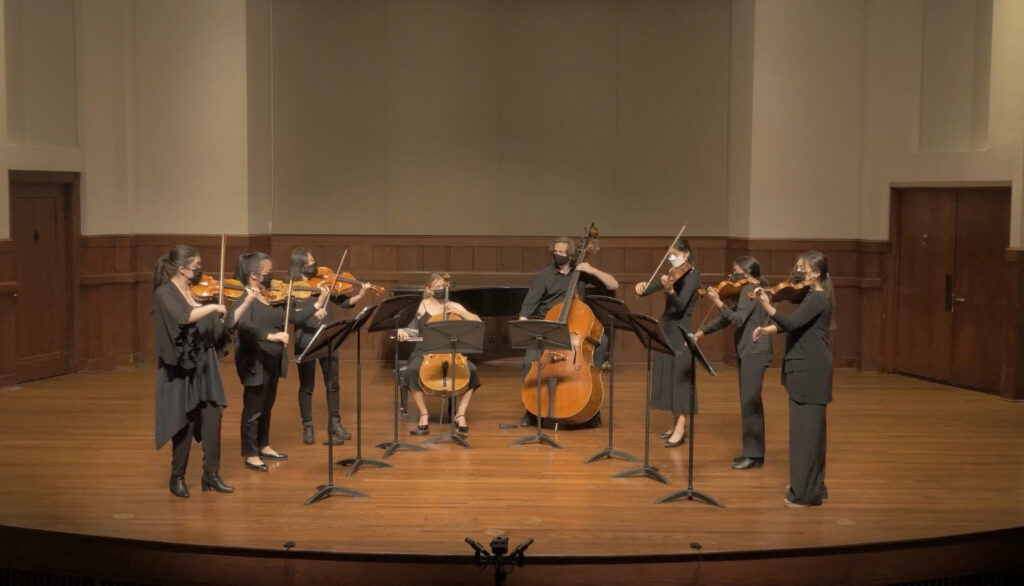
In addition to the Large Ensembles course that’s part of Thornton’s curriculum, we perform in chamber ensembles every semester. This course seeks to expose students to various forms of chamber music and teach us how to collaborate with others. Over the past four years, we’ve played in all different types of groups, from duets to octets, and chosen repertoire from all different periods of music. We have the choice to form our own ensembles or are placed into groups by the Head of Chamber Music. Once we’re in groups, we schedule coachings with a Thornton professor, who helps guide us throughout the semester. It’s a wonderful opportunity to work and gain insight from them, especially since they may not be guided by your private lesson professor, but rather with another amazing faculty member.
Thornton provides lots of performance opportunities in chamber music. Throughout the semester, we have a range of open performance opportunities, as well as the privilege to participate in masterclasses with major quartets. For example, the upcoming chamber music masterclass will be held with the Verona Quartet, in which two groups from the strings chamber department will present works they have been working on this semester. In addition, on top of masterclasses, there are a few competition opportunities for chamber groups. The most notable competition opportunity is the annual Ofiesh competition—winners get to perform in Europe at an international music festival over the summer. It is an amazing opportunity to not only get to travel and perform, but also connect with other musicians around the globe.
By the end of each semester, every chamber group performs at the Chamber Festival, which usually spans across two evenings. The festival itself does not have a theme, and therefore, it is quite fun listening to the various repertoire and group projects. For example, we had the privilege of listening to works from Shostakovich, Mozart, Beethoven, Mendelssohn, Schubert, etc.—all in one evening! Not only is it a valuable experience to showcase the work we have been putting into our groups over the semester, but it is also a great way to support, cheer and be inspired by our peers’ hard work.
Sofia Chamberlain and Emily Hsu celebrate with their peers after their recitals and concert performances on campus at USC. (Photos courtesy of Sofia Chamberlain and Emily Hsu)
One of our favorite memories in chamber music is Chamber Reading Night, which takes place at the beginning of each semester. It’s a great opportunity to get to know other students within the Strings department and sight read for fun. Faculty members join in and play with us too. Although we initially start out nervous, as we are largely concerned with messing up, we quickly realize that everyone at Thornton is here to support each other. There is no greater sense of community fostered than laughing over an initial reading of a Beethoven string quartet, or playing with a constantly shifting group as students hop from room to room.
Although we have highlighted our performance experiences specifically with orchestra and chamber music, there are many more performance opportunities for students, from degree recitals to jam sessions to outside gigs, all of which feed into the larger network that is Thornton. We have found that all these performance opportunities share something in common: the idea that the Thornton School is truly a supportive community. Over our four years here at Thornton, we have learned how performing can be a learning experience, and an opportunity to support one another within our own personal music journeys. Above all, we believe that through these performance opportunities, we have discovered our own artistic voices—whether it be for solo, chamber music, or orchestra—and we will continue to build our music through the support of the Thornton community.
Ella Kaale (Composition | Class of 2025)
“What performance opportunities are there?” is one of the most common questions I get asked as a USC Thornton Student Ambassador from prospective composition students. When I was applying to college, this was something I cared deeply about too. It’s difficult for anyone to say what events are guaranteed each year, but I am happy to use this blog space to share about the performance opportunities I’ve gotten to experience so far here at the Thornton School of Music. The Composition Department has a variety of student recitals each year, including some of the most unique opportunities of any school.
Our foremost space for new music premieres is our Comp Showcase, held once a semester. These concerts truly encapsulate how kaleidoscopic our department is. Not only do all degree levels (B.M., M.M., D.M.A.) participate, but the variety of genre, instrumentation, medium, etc. is so inspiring. You’ll find at any given Comp Showcase that the idea of a “prescribed style” is nonexistent at Thornton. Chamber pieces, electronic or multimedia works, pop songs and experimental projects all have taken the stage at Comp Showcase.
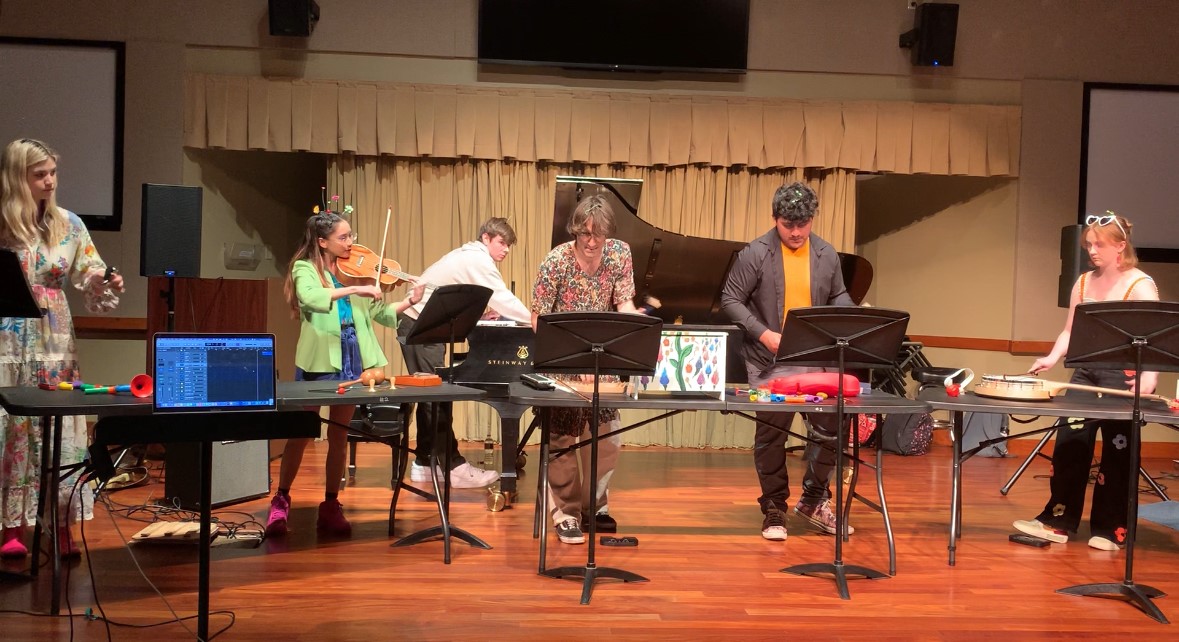
Since I’ve been at USC, I have participated in Comp Showcase six times: four times with my own work in the program, and five times playing cello or singing on my friends’ pieces. Of course, it’s fun to have my pieces premiered, but the true highlight of Showcase for me is performing. After I graduated high school, I thought I would never play cello again, and even considered leaving my instrument at home in Texas. However, I’ve found a new passion for the cello through collaborating with my peers, helping them fulfill their ideas, and remembering why I love to perform chamber music.
Similarly structured to the semesterly Showcase is the annual Electro-Acoustic Showcase. If Comp Showcase is experimental, Electro-Acoustic Showcase (EA Showcase hereafter) is nuclear. Once a year, our newly established Electronic Music Studio built by Professor Nina C. Young creates a unique space for composers to present technologically ambitious projects. I have performed my friends’ pieces twice at EA Showcase and my own once (I’m so excited to perform and premiere more pieces at our upcoming EA Showcase at the end of March!).
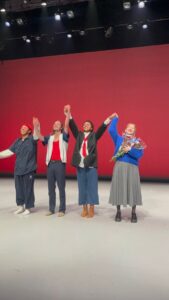
There are two performance opportunities that are exclusive to undergrads–both structured into the curriculum and occurring in the sophomore year. The first is the Composers and Choreographers Showcase (CNC for short!), in which the sophomore class of composers gets to collaborate with the sophomore B.F.A. Dance students from the USC Glorya Kaufman School of Dance, right across the street from Thornton. At the end of the fall semester, the composers are paired with dancers and spend the spring semester working on completely unique and mesmerizing pieces. This is a rare opportunity for even career composers, so I am beyond grateful for the experience and product my choreographers/dancers and I made. Some of the most fun (albeit superficial) parts of CNC were getting to use Kaufman School’s facilities, allowing us to include complicated lighting cues and incredible overhead sound.
The other undergrad-exclusive performance opportunity is Sophomore Showcase! This was one of the most fulfilling experiences I’ve had at USC so far. In addition to using the spring semester to work on CNC, the sophomores get to curate a concert focused solely on their work, held at the very last Composition Forum of the semester. My class and I put blood, sweat and tears (in the best way!) into our Sophomore Showcase. We each premiered a brand-new piece, and many of us played each other’s pieces. I wrote my piece for all six of us to play toy instruments.
Twice since I’ve been at USC, I’ve had the opportunity to write new pieces for world-class Ensembles in Residence, including Hub New Music in 2022 and TAK Ensemble in 2023. Working with the ensembles is so special. These performers are crucial arbiters of the future of new music, and thus getting to workshop your pieces with them is exhilarating and eye-opening.
In my opinion, the “crown jewel” of performance opportunities for USC Composers is the New Music for Orchestra Concert (NMO). Once a year, the faculty hold a call for scores from any student in the department. The selected works are then workshopped and premiered in a grand concert at Bovard Auditorium by the Thornton Symphony and conducted by Donald Crockett. I was lucky enough to have a piece selected for last year’s concert. NMO was the single most valuable learning experience in my education so far—any composer who has worked with an orchestra knows how humbling, shocking and ultimately fulfilling the dialogues between composer, conductor, scores, parts, library and orchestra are.
Ultimately, there is no shortage of performance opportunities for composers at Thornton. Exciting new concerts are held every semester, so you never know what you might get to write music for next!
